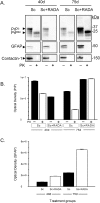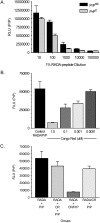Inoculation of scrapie with the self-assembling RADA-peptide disrupts prion accumulation and extends hamster survival
- PMID: 19212437
- PMCID: PMC2636877
- DOI: 10.1371/journal.pone.0004440
Inoculation of scrapie with the self-assembling RADA-peptide disrupts prion accumulation and extends hamster survival
Abstract
Intracerebral inoculation of 263K Scrapie brain homogenate (PrPsc) with a self-assembling RADA-peptide (RADA) significantly delayed disease onset and increased hamster survival. Time of survival was dependent on the dose of RADA and pre-incubation with PrPsc prior to inoculation. RADA treatment resulted in the absence of detectable PrPsc at 40 d followed by an increased rate of PrPsc accumulation at 75 d up to sacrifice. In all PrPsc inoculated animals, clinical symptoms were observed approximately 10 d prior to sacrifice and brains showed spongiform degeneration with Congo red positive plaques. A time-dependent increase in reactive gliosis was observed in both groups with more GFAP detected in RADA treated animals at all time points. The PrP protein showed dose-dependent binding to RADA and this binding was competitively inhibited by Congo Red. We conclude that RADA disrupts the efficacy of prion transmission by altering the rate of PrPsc accumulation. This is the first demonstration that a self-assembling biomolecular peptide can interact with PrPsc, disrupt the course of Scrapie disease process, and extend survival.
Conflict of interest statement
Figures






Similar articles
-
Proteinase-resistant prion protein accumulation in Syrian hamster brain correlates with regional pathology and scrapie infectivity.Neurology. 1991 Sep;41(9):1482-90. doi: 10.1212/wnl.41.9.1482. Neurology. 1991. PMID: 1679911
-
High prion and PrPSc levels but delayed onset of disease in scrapie-inoculated mice heterozygous for a disrupted PrP gene.Mol Med. 1994 Nov;1(1):19-30. Mol Med. 1994. PMID: 8790598 Free PMC article.
-
Mouse-adapted scrapie strains 139A and ME7 overcome species barrier to induce experimental scrapie in hamsters and changed their pathogenic features.Virol J. 2012 Mar 9;9:63. doi: 10.1186/1743-422X-9-63. Virol J. 2012. PMID: 22400710 Free PMC article.
-
Prion encephalopathies of animals and humans.Dev Biol Stand. 1993;80:31-44. Dev Biol Stand. 1993. PMID: 8270114 Review.
-
Genetic and infectious prion diseases.Arch Neurol. 1993 Nov;50(11):1129-53. doi: 10.1001/archneur.1993.00540110011002. Arch Neurol. 1993. PMID: 8105771 Review.
Cited by
-
Self-assembling peptides for stem cell and tissue engineering.Biomater Sci. 2016 Apr;4(4):543-54. doi: 10.1039/c5bm00550g. Epub 2016 Feb 15. Biomater Sci. 2016. PMID: 26878078 Free PMC article.
-
Hampering the early aggregation of PrP-E200K protein by charge-based inhibitors: a computational study.J Comput Aided Mol Des. 2021 Jun;35(6):751-770. doi: 10.1007/s10822-021-00393-7. Epub 2021 Jun 10. J Comput Aided Mol Des. 2021. PMID: 34110550 Free PMC article.
-
Novel epitopes identified by anti-PrP monoclonal antibodies produced following immunization of Prnp0/0 Balb/cJ mice with purified scrapie prions.Hybridoma (Larchmt). 2012 Oct;31(5):314-24. doi: 10.1089/hyb.2012.0022. Hybridoma (Larchmt). 2012. PMID: 23098297 Free PMC article.
References
-
- Bolton DC, McKinley MP, Prusiner SB. Identification of a protein that purifies with the scrapie prion. Science. 1982;218:1309–1311. - PubMed
-
- DeArmond SJ, Yang SL, Cayetano-Canlas J, Groth D, Prusiner SB. The neuropathological phenotype in transgenic mice expressing different prion protein constructs. Philos Trans R Soc Lond B Biol Sci. 1994;343:415–423. - PubMed
-
- Mallucci G, Dickinson A, Linehan J, Klohn PC, Brandner S, et al. Depleting neuronal PrP in prion infection prevents disease and reverses spongiosis. Science. 2003;302:871–874. - PubMed
Publication types
MeSH terms
Substances
LinkOut - more resources
Full Text Sources
Medical
Research Materials
Miscellaneous

